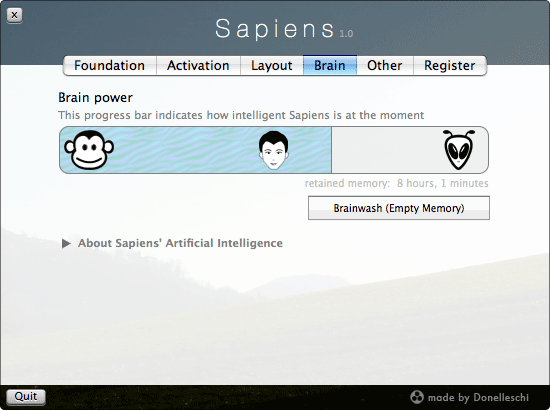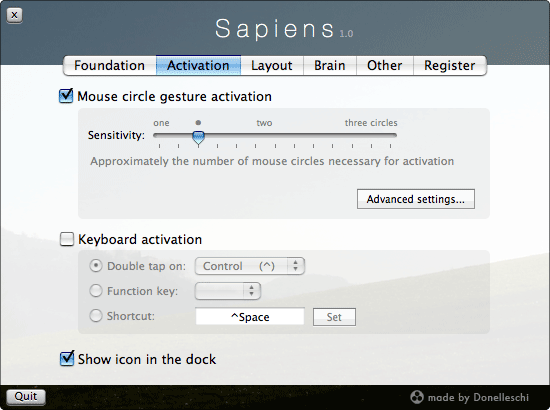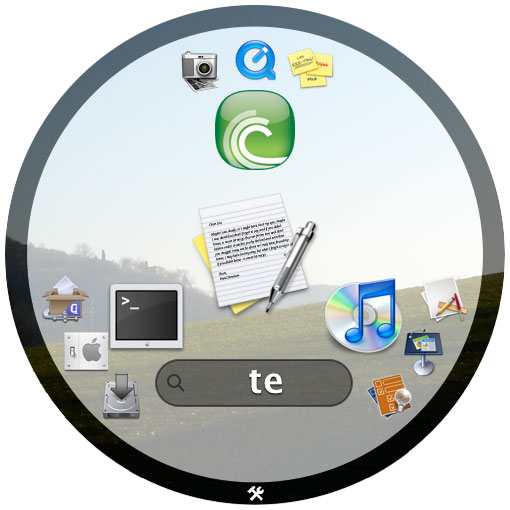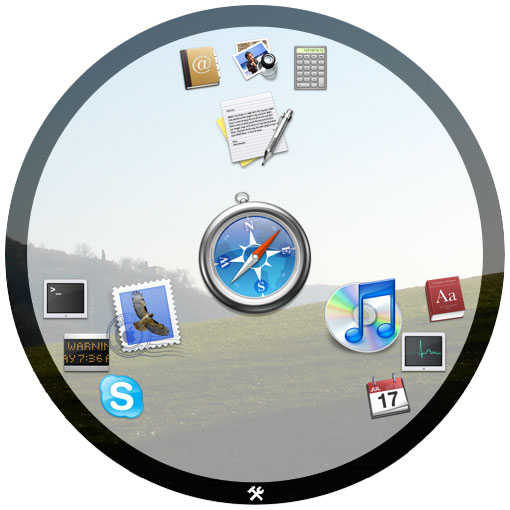Sapiens has been designed around four design principles:
- intelligence
- mouse access
- search as a last resort
- kinesthetic memory
By reading about them you will also understand how Sapiens works and why it works in this way.
 T
The average Mac user has about 100 applications installed in his/her system, but only a third has been used to some extent, and just a tenth is used regularly. Sapiens can accurately learn and understand the applications you use and is therefore able to make reliable predictions about the set of applications you are most likely to launch. For this reason it may take 2-3 days for it to have a enough brain power to make accurate predictions. And of course as your habits change sapiens keeps adapting to them by constantly learning from you.

We would like to achieve what we call a "launch at first sight experience". Our eyes are extremely fast and can find the right icon in a few milliseconds, provided the icons are visible and there are not too many on screen. Because Sapiens knows what applications you are likely to launch (see intelligence), it can show you the few icons that you really care about.
Given these premises, we also need a way to activate Sapiens with the mouse. If we would use a keyboard shortcut such as control-space for example, we could just as well perform a standard search since our hands are on the keyboard already. Because we want you to solely use the mouse we came up with an innovative way to invoke Sapiens: a mouse gesture. To activate Sapiens you can simply move your mouse in a circle until Sapiens appears.
This mouse gesture also opens a new era of drag & drop. If you want to open a file with a specific application, simply drag the file and move the mouse in circle. Sapiens will be activated and you will be able to drag your file over the application you want to open the file with.
Obviously you can enable a keyboard shortcut too, but we encourage you to use the mouse circle activation to access Sapiens.
Both the icons' visual layout and the mouse gesture activation make an amazing "launch at first sight experience" possible.

Sapiens will try predict to the applications you want to launch, but it may not always be 100% correct. Especially at the beginning when you are using Sapiens for the first time and Sapiens hasn't learned much from your habits, you may want to search. searching is very easy: by simply beginning to type at anytime, you will prompt a search field to show up and the result will come as you type. Sapiens searches for substrings also. For example, if you type "cal", both iCal and Calculator will be found. It also searches for abbreviations, for example if you search for "TE", TextEdit will show up.
If you want to visually browse your applications, you can also use the mouse scroll wheel (or the arrow-keys) to move through your applications.

The layout in which applications are shown is radial and is not as random as it might seem. You can think about it as a solar system in which the icons represent planets and satellites.
Each application is associated with a radial category and therefore will be always in the same radial position. For example the Preview application is always at the top in the default layout called "Trinity". This fixed position of the applications is very important because it helps you develop what is known as Kinesthetic Memory. This is a form of learning in which your body passively remembers gestures and actions by performing them. A good example of Kinesthetic Memory can be found the way we use keyboards (of computers or cellphones): we type right but we don't really know where the specific keys are.
As you start using Sapiens everyday, you will realize that your eyes look for a specific application in specific position. For example you will always look at the top for the Preview application, or at the bottom right for iPhoto.
The way applications are associated to a radial category is immutable and it is the same on every single Mac, whether you are using your home iMac or your friend's MacBook. It doesn't matter: your Kinesthetic Memory will help you find what you are trying to launch.

.gif)







